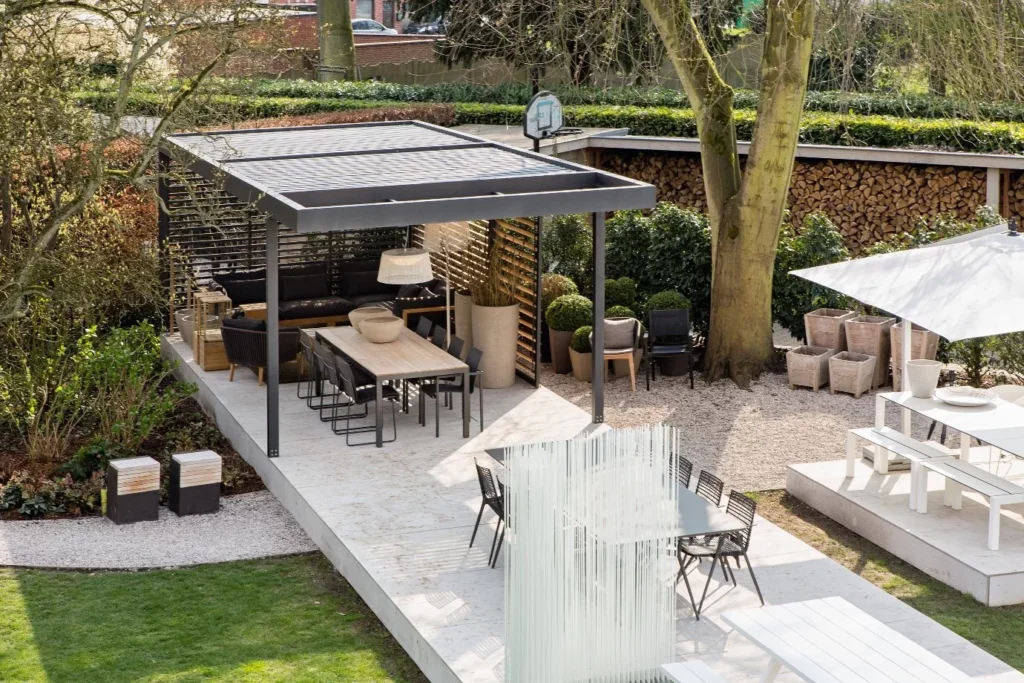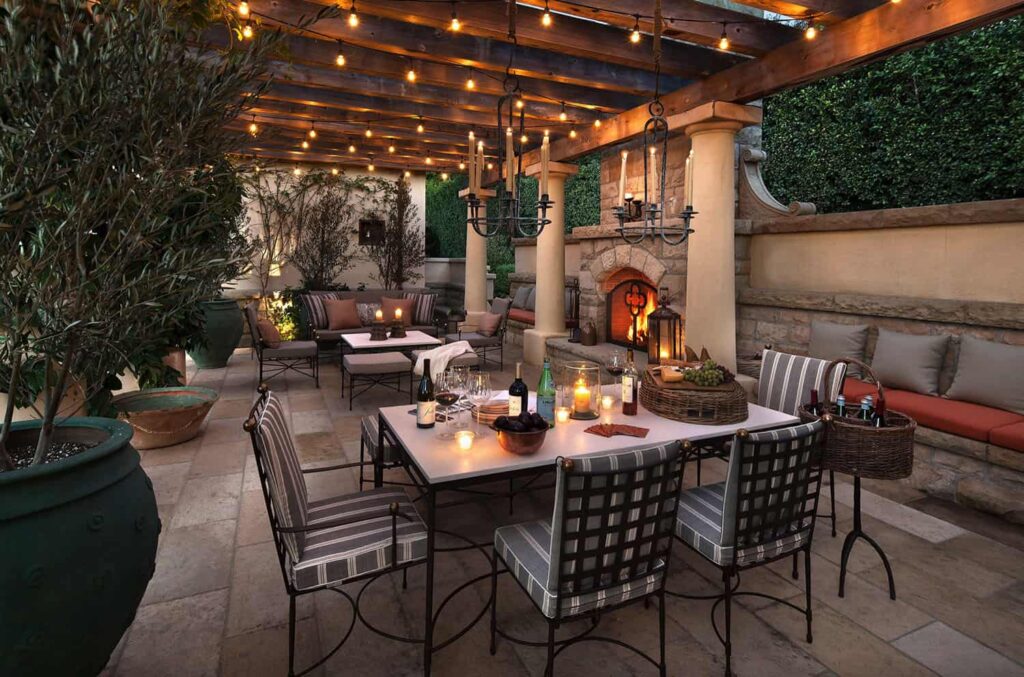In recent years, outdoor dining has transformed from a seasonal pleasure to a year-round necessity for restaurants and cafes worldwide. This shift, driven by health considerations and a collective craving for open, breathable spaces, has prompted businesses to rethink and reinvent their outdoor dining experiences. As we navigate these changes, the creativity and adaptability of the food service industry have come to the forefront, offering diners innovative outdoor options that cater to comfort, safety, and aesthetic appeal. This article talks about the top trends in outdoor dining, focusing on how businesses can make the most of their spaces to provide unforgettable experiences for their patrons.
1. Eco-Friendly Dining Spaces

Sustainability is more than just a trend; it’s a commitment to the planet that’s increasingly reflected in outdoor dining setups. Restaurants are turning to recycled materials for their tables and chairs and embracing eco-friendly practices that resonate with environmentally conscious diners. From biodegradable utensils and composting food waste to minimizing single-use plastics, these efforts contribute to a greener dining experience that patrons can feel good about supporting.
2. Smart Technology Integration
The integration of smart technology into outdoor dining areas enhances the customer experience through convenience and efficiency. QR code menus, accessible from diners’ smartphones, eliminate the need for physical menus, reducing contact and waste. Online ordering systems and contactless payment options streamline the dining process, minimizing wait times and allowing for a smoother, more enjoyable meal.
3. Enhancing Mobility with Carts
For restaurants looking to expand their outdoor dining services, grab-and-go carts present a versatile solution. A manufacturer of high-quality grab-and-go carts offers businesses the opportunity to serve customers efficiently in outdoor settings, whether it’s through quick snacks, beverages, or full meals ready to be enjoyed on-site or taken away. These carts can be strategically placed to maximize foot traffic and cater to the fast-paced lives of diners seeking quality food without the wait.
4. Multifunctional Furniture

The demand for outdoor dining has necessitated the use of multifunctional furniture that can adapt to various dining scenarios and space limitations. Foldable chairs and tables offer the flexibility to adjust seating arrangements as needed, while modular seating can accommodate both small groups and larger gatherings. This versatility ensures that outdoor spaces can be quickly reconfigured to meet changing customer needs, making the most of available dining areas.
5. Outdoor Heating and Cooling Solutions
To make outdoor dining comfortable year-round, businesses are investing in heating and cooling solutions tailored to their climates. Infrared heaters provide warmth during cooler months, extending the outdoor dining season and creating a cozy atmosphere for patrons. During warmer periods, misting fans and strategically placed shade structures keep diners cool and comfortable, encouraging them to linger longer and enjoy their meals.
6. Creative Lighting Solutions
Lighting plays a crucial role in setting the mood and ambiance of outdoor dining spaces. From twinkling fairy lights strung across patios to elegant lanterns and solar-powered options, creative lighting solutions illuminate dining areas and enhance their aesthetic appeal. Proper lighting can transform an ordinary outdoor space into a magical dining environment, inviting diners to relax and enjoy their surroundings.
7. Themed Outdoor Dining Experiences

Creating an immersive outdoor dining experience through thematic decorations and music has become a popular trend among restaurants looking to stand out. From a beach-inspired oasis with sand and surfboards to a garden setting filled with flowers and fairy lights, these themes offer guests an escape from the ordinary. Special menus that align with the theme can further enhance the dining experience, making each meal memorable and unique. This trend allows restaurants to tap into the storytelling aspect of dining, where every element contributes to a cohesive narrative that engages and delights customers.
8. Landscaping and Green Spaces
Incorporating landscaping and green spaces into outdoor dining areas beautifies the space and creates a more inviting and relaxing environment. Well-planned landscaping can provide natural shade, reduce noise from surrounding areas, and improve air quality, all of which enhance the overall dining experience. Adding elements like vertical gardens, flower beds, or even small water features can transform a simple dining area into a lush, serene getaway that encourages diners to stay longer and return more often.
9. Privacy and Space Management
As outdoor dining becomes more prevalent, maintaining a sense of privacy and efficiently managing space have become crucial considerations. Utilizing strategic elements like planters, screens, or trellises can help delineate dining areas and offer guests privacy from the hustle and bustle around them. These features can also serve as aesthetic enhancements, adding to the ambiance of the space. Effective space management ensures that guests feel comfortable and secluded, even in busy or compact areas, making their dining experience more enjoyable.
10. Pop-Up Dining Events

Pop-up dining events in outdoor settings have surged in popularity, offering chefs and restaurateurs the opportunity to showcase their culinary skills in unique locations for a limited time. These events often feature exclusive menus and are held in unexpected places like rooftops, gardens, or historic sites, providing a sense of adventure and exclusivity. Pop-up dining allows restaurants to experiment with new concepts and menus in a less formal setting, attracting food enthusiasts eager for novel experiences.
11. Integration with Local Culture and Art
Outdoor dining spaces are increasingly becoming platforms for showcasing local culture and art. This trend includes featuring live music from local bands, displaying artwork from local artists, and hosting cultural events that reflect the community’s heritage. Such integration enriches the dining experience, fostering a connection between the restaurant and its local culture. It supports local artists and musicians, creating a vibrant, culturally rich atmosphere that guests appreciate.
12. Health and Safety Innovations
In the wake of global health concerns, innovations in health and safety have become paramount in outdoor dining settings. Restaurants are implementing measures like sanitation stations, UV light sanitizers for cleaning tables and chairs, and layouts designed to maintain social distancing without sacrificing ambiance. These innovations reassure guests of their safety while dining out, allowing them to relax and enjoy their meals with peace of mind.
Conclusion
The evolution of outdoor dining is a testament to the restaurant industry’s resilience and creativity. By embracing trends such as these, restaurants can create outdoor dining spaces that offer more than just a meal—they provide an experience. These trends not only cater to the changing preferences of diners but also offer restaurants the opportunity to expand their offerings and explore new ways to engage with their customers. As we look to the future, it’s clear that outdoor dining will continue to play a significant role in the culinary world, pushing the boundaries of what’s possible and redefining how we experience food and community.


